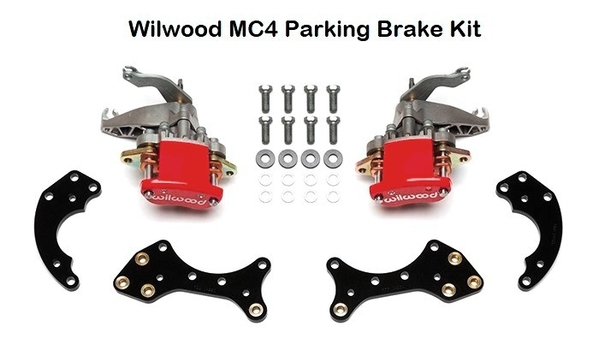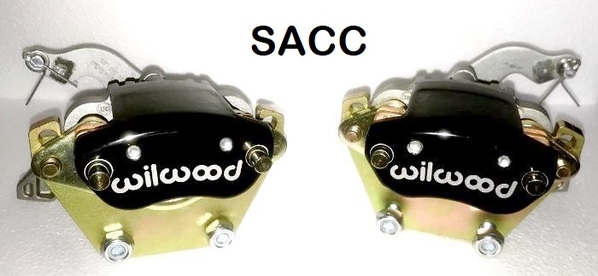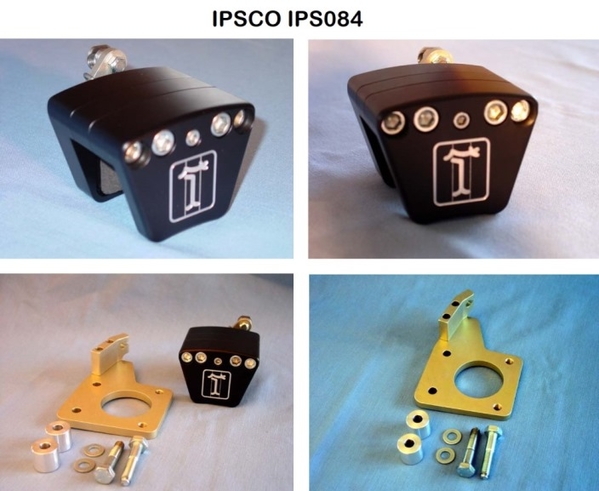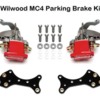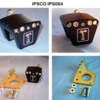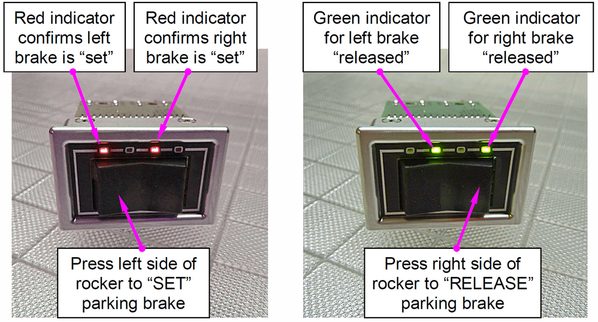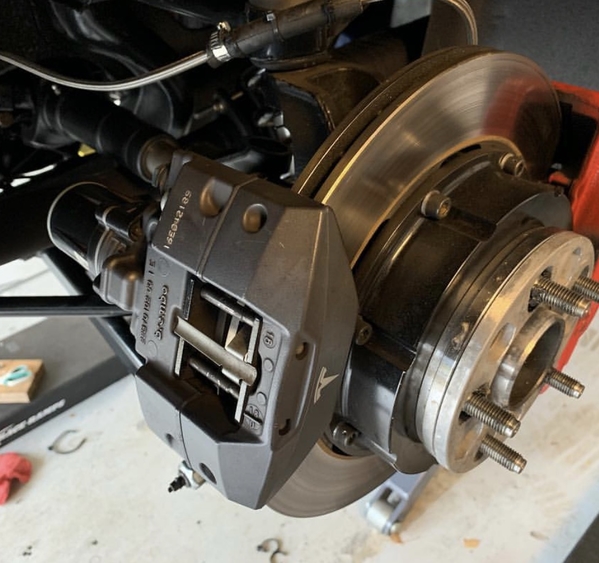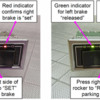A few years ago I installed (on my '73 L) one of the brake upgrade kits that utilizes Corvette rotors and calipers and uses a line lock for the parking brake since the factory park brake components don't fit. Initially all was fine, but the line lock has lost effectiveness over time so that I don't think it will pass the state safety check. Also, the local garages (Massachusetts) now sit in the car and apply the parking brake themselves to be sure you are not "faking it" when told to apply it. My question is: does someone sell a bracket kit to re-install the factory park brake, or is there another DOT approved device I can use in place of the line lock? Thank you!
Replies sorted oldest to newest
There’s another option: Pantera Electronics Tesla/Brembo electronic parking brake calipers. You’d think the calipers were expensive but you can buy a pair on eBay for about $150 or less. Most of the calipers are aluminum but later versions are composite. This allows you to eliminate the OEM parking brake handle, bracket, cables, etc. and leave more room for aftermarket seats. Pantera Electronics manufactures the switch/controller and has the parts you need to install the calipers; connectors, cable, etc.
Attachments
The Wilwood mechanical caliper (go-kart spot brake) shown is what I adapted in 1998 to our Pantera with altered rear brakes. I made a pair of adapter brackets and cable-directors; the same caliper with a different bracket is what Pantera East sold for Panteras and Vipers for quite a while. IPSCO now sells something similar. Mine works fine with stock brake cables, except there is no anti-rattle spring so with the windows down, you can hear the little pads and backing plates moving around. No worries after 20 yrs of driving. Wilwood also makes an invisible e-brake that is of the early Corvette 2-shoe design built inside the rotor hat sections.
The Wilwood Mechanical Calipers shown above are NOT go-kart spot brake Calipers. The MC4 Parking Brake Caliper is a great performing mechanical parking brake caliper that Wilwood uses for most of their brake kits that don't have the old drum brake shoe design.
Tesla Caliper - as everyone may or may not know, the reason that Tesla calipers are so cheap on eBay (you can find them between $66 a pair, and $150 a pair) is most likely because they came off the 2016 models when they were 53,000 vehicles recalled for parking brake issues.
The cheaper pairs of calipers have the connector housings broken, on the more expensive ones, the connector housings are intact.
How do you find out if the calipers have the plastic gear that may prevent them from being retracted?
Can they be repaired or updated so that this would not be an issue on a retrofit?
I know this Tesla thing is a pretty new modification to our cars, but I’d be pretty irritated if I spent $700 on all the components and mounted it up, and then found an issue with the calipers.
Thanks -
Rocky
Rocky, all of the Tesla Model S PB calipers I've seen on eBay have been taken from wrecked Tesla's. There seems to be a lot of them! The calipers that were exchanged under warranty were supposed to have been destroyed by the servicing dealer. Imagine the liability risk a dealer would suffer if they were taking those "exchanged under recall" calipers and selling them on eBay! That being said, only 5% of them were defective, so if some found their way onto eBay, chances are they're OK. I agree with you; the challenge, buying them on eBay is, receiving undamaged units. The electrical connector is extremely vulnerable and even if it is intact before shipping, if the packaging isn't great, the calipers will be delivered with broken connectors.
I bought a pair of the later composite PB calipers on eBay for $75 each and they look like brand new units. They came with pads too! I went this route for one simple reason; it allowed me to eliminate the e-brake handle and move my Recaro passenger seat a few inches closer to the console.
Are you really allowed to change a parking brake electrically operated just like that? I would have thought that if it is required as a safety device the parts would need some kind of approval.
-Sami
Yes....
In America, it is (supposed to be) “Everything is allowed except that which is forbidden”, vs. “Everything is forbidden except that which is allowed”.
![]()
There are very few states anymore that have safety inspections, and I’m not aware of any that force the car to be 100% stock, although they do make you do that for emissions testing....
@rocky posted:Yes....
In America, it is (supposed to be) “Everything is allowed except that which is forbidden”, vs. “Everything is forbidden except that which is allowed”.
I see.
I thought it might be some sort of safety issue to use a third party controller, your DIY wiring between controller and calipers and operate them with a $0.50 rocker switch...
After all, you live in the promised land of lawsuits... ![]()
-Sami
Maybe that’s why we have so many lawsuits...
But if you are going to make that argument, than any of the other parking brake offerings would be similarly bad....
This is a PARKING brake, after all.
And if it holds, there’s no reason for a lawsuit. But if your 50 year old stock brake fails on Lombard St. in San Francisco, you are probably in just as much trouble....

Attachments
Electric parking brakes work like power windows. They stay in whatever state you leave them in. Power is only required to change the state. If you set the brake, then have a controller/switch failure, or a dead battery, the PB will stay set.
Can you park on Lombard St.???
I doubt it. It was mere hyperbole!
A quick update on the Tesla Brake install I am currently doing for 6997. The calipers are all in and fit well with no real clearance issues. The original calipers are flipped to the front and sway sides to keep the bleeder up. Slightly longer brake lines are required. The Pantera Electronics controller works well and the EPB units set and reset well . And there is no way they are moving once they are set ! The box fits nicely under the center console. I think this is a good option if you are sick of the lousy manual park brakes letting go on you.
Now where to mount that pesky push button .......?
Attachments
Percy, one possible trouble spot. The placement of that black box under the center armrest: one guy put such a box at that point, and when he also velcro-ed a CB radio on top of the armrest and keyed the transmitter, the box shut off from induced voltage! And since it was an intermittent failure (only happened when the transmitter was keyed), it took weeks to find it.... I don't know whats in your black box nor if you use CB radios, but it can happen if things line up just right.
Thanks Bosswrench. Great observation of a situation that would absolutely drive you mental trying to find it !
Just one comment on the install is to go with the optional cable and plug pack supplied by PE but ask Jon to provide some extra pins for the plugs just in case . I stuffed up the pins in the plug assembly to the Brembos initially and had to redo them and they have to be absolutely perfect. I could not get those plugs here so was waiting while Jon sent me extra pins. Also you might request another 3m of cable over the standard loom run offered . That would give you enough length to get to the front firewall next to the covered area in front of the brake cylinder. The box could then be easily mounted there away from spilt coffee and CB radios. That would have been my ideal but I just could not make the distance. That would be a better spot with shorter runs for access to the fuse panel power and the push button mounting . Next time I would also get a four pin male/female plug supplied at the get go to make the disconnect on the push button easier.
I have also installed the PE cooling controller relay with the separate 35 A resettable breaker which feeds directly off the battery . This had freed up fuse 11 for the original Fan relay circuit so I was able to repurpose that fuse for a 20A dedicated run for the Brembos. You will need a 20A protected circuit for this.
Just a couple of things to think about if you consider doing it.
I have a couple of 5w handheld units that I use car to car which I find ideal. There is already enough gizmos cluttering up every nook and cranny!
Davidnunn - one question - you mentioned you cut the e-brake mount boxing out ? Did you seal the floor recess ?
Do you have any pictures of what it looked like after you did it ?
Percy,
Yes, I cut out the e-brake lever mounting "box" then filled in all the holes. I have lowered floor pans so the holes I needed to fill in were different than the ones you'd have in a stock floor pan.
Why does the Pantera caliper get moved to the front and replaced with the Tesla? Why can't it be mounted in front?
Why can't the Tesla caliper just replace the Pantera caliper entirely?
The motor drive on the Tesla electric caliper fouls the shock spring when you try to mount it in the front position . The mount extension for the manual Emergency brake cable on the original caliper clears the spring so the whole thing is fully reversible - no caliper trimming required. With the two sets of ears already on the Pantera mounting case it is a very simple change.
The Tesla electric caliper is not modulating - its either full on or off. I know some work is being done to see if it can be operated as a modulating caliper but no word on that as yet. Even if that was possible , the entire brake arrangement for the car would have to be modified, both front and back, to make this work as the primary caliper. I wouldn't do it.
As it is this is, it is a relatively simple , fully reversible modification that delivers outstanding emergency brake service . And it gets rid of the inside handbrake lever.
Hope this helps ?
The Tesla caliper is just a parking brake. Some OEMs have an EPB built into hydraulic calipers but I'm not aware of anyone retrofitting them to a Pantera. Physically adapting them is simple; it's the controller/electronics that's the hard part. Lucky for us, Pantera Electronics has a controller for the Tesla EPBs.
When you apply the Tesla EPB, it doesn't just "grab" the rotor, it applies itself progressively; over 2 or 3 seconds. There's a Hall Effect sensor built into the motor that controls the speed the caliper closes on the rotor.
@Percy posted:The motor drive on the Tesla electric caliper fouls the shock spring when you try to mount it in the front position . The mount extension for the manual Emergency brake cable on the original caliper clears the spring so the whole thing is fully reversible - no caliper trimming required. With the two sets of ears already on the Pantera mounting case it is a very simple change.
The Tesla electric caliper is not modulating - its either full on or off. I know some work is being done to see if it can be operated as a modulating caliper but no word on that as yet. Even if that was possible , the entire brake arrangement for the car would have to be modified, both front and back, to make this work as the primary caliper. I wouldn't do it.
As it is this is, it is a relatively simple , fully reversible modification that delivers outstanding emergency brake service . And it gets rid of the inside handbrake lever.
Hope this helps ?
There are other hydraulic rear calipers with electronic parking brakes. Surface areas of the pads (a comparison for braking amount applied) are similar in some cases.
Why does it have to be the Tesla?
How does the Tesla caliper work as a rear caliper on a Tesla IF it only operates as Parking Brake, i.e., on and off?
The way that some modifications that become suddenly popular then overnight become yesterdays news when a better modification comes up is my concern here.
The idea of eliminating the interior hand brake assembly I like but the thought of just an electric on/off activating switch with no safety on it is concerning, or maybe more accurately stated, a consideration?
How do you protect from a disastrous situation of accidentally applying the parking brake while driving?
I asked "Professor Haas" this and he hasn't responded as of yet? He's still on his time trip in his "Delorean" and is trying to get back to the future.
Doug, the Tesla Model S has two rear calipers; a hydraulic brake caliper and an electric parking brake caliper. They are both made by Brembo. The EPB is simply an electric version of Brembo’s manual parking brake that’s used on many different cars, including the Viper, Lamborghini, Ferrari, etc. The Brembo EPB is also used on different cars but removed from a wrecked Tesla, it is cheap and readily available. Removed from a wrecked Lamborghini Aventador, it still costs a fortune.
BTW, the Tesla version is designed for a 1-1/8” wide rotor.
You can avoid the EPB being applied at speed by not pressing the button! Duh 🙄! It would be easy for Jon to modify his controller to use a VSS input but I can’t imagine there’d be any demand.
I'm learning here about the Tesla application but as I do I'm also considering how my particular installation could/would/will be.
The location in the cabin of the switch is not a moot point. That COULD be a disaster waiting to happen.
A VSS connection is the only way I can conceive of a safety on the switch at this moment also.
Do you remember "Car 54, where are you"? Toody and Mouldoon. "OOO, OOO!"
I need to get over that impulse and work this out further.
I get the part about the "used, wrecked Tesla" source being "affordable" so far. I'm just wondering about other alternatives BUT I already have an idea where to put the switch and a safety would be HIGHLY desirable.
As it turns out, I already have a new VSS that I sourced for a "stilborn" EFI project that I never did. I settled on the dirty, dirty, highly anti-social Weber 48ida's. Me bad BUT I GOT a new VSS out of it.
Hey Jon? What ya' doin' today?
Doug, if you had followed through on your EFI project, assuming you had incorporated a VSS, it would be easy to power the EPB controller with a relay that's controlled by the ECU. You could even set a speed threshold. Car moving >5 mph = no power to EPB !
But I didn't so where you goin' with this David?
It does seem obvious to me that there are apparent pit falls to this modification.
I am not enamored by some rinky-dink console switch changing colors. I'm sure my 3 year old grandson might be though.
Then don't do it. Problem solved!
There are two control options with the PE controller. One is the push button option, the other is a switch using the original handbrake unit itself. If the concern is the switch may be pushed , go for the handbrake option. It will look identical to what is standard and unless the grandson has a predisposition to high speed handbrake turns, will present exactly the same risk as what you currently have.
I believe you have to specifically request the controller for the hand brake option ? Ask PE to confirm. The board seems to take both types of inputs so I am not sure what the difference is other than the switch.
Well I'm glad that you came to that conclusion about me David and pointed out the obvious. I suppose, someone feels entitled to do that here and it must serve some sort of positive purpose?
I do thank everyone for sharing the information that they have. It is helpful.
The only thing that I can conclude at this point is that I don't care for the options available and at this time it just isn't something for me.
Maybe things will change at some point?
Part of the problem here is the indiscriminate use of "Emergency Brake" and "Parking Brake" which are two separate functions. The USDOT specified emergency brakes as being able to stop a passenger vehicle within a specified distance without locking the wheels and/or losing control. They require a totally separate linkage from the main brakes. To my knowledge, parking brakes are only used on skip-loaders and fork-lifts without Fed specs and do NOT substitute for emergency brakes.
@bosswrench posted:Part of the problem here is the indiscriminate use of "Emergency Brake" and "Parking Brake" which are two separate functions. The USDOT specified emergency brakes as being able to stop a passenger vehicle within a specified distance without locking the wheels and/or losing control. They require a totally separate linkage from the main brakes. To my knowledge, parking brakes are only used on skip-loaders and fork-lifts without Fed specs and do NOT substitute for emergency brakes.
I was thinking the same thing. So is the Tesla an emergency brake or a parking brake?
How do you use an electric brake in an emergency? Ordinarily wouldn't the cpu take charge and brake the car gradually without locking up the rear brakes? All the driver can do is push the engage button?
The Tesla's EPB is a parking brake only. It will not operate until the vehicle is stopped. Most new cars use EPB's that operate exactly the same way. Even Porsche's been using EPB's since the 2012 model year.
@davidnunn posted:The Tesla's EPB is a parking brake only. It will not operate until the vehicle is stopped. Most new cars use EPB's that operate exactly the same way. Even Porsche's been using EPB's since the 2012 model year.
Are you refering to it's function on a Tesla that uses a cpu or on a Pantera with Pantera-Electronics "brake controller" device?
In private discussions with P-E I am told that the brake is either on or off and the device is just an adapter for the Pantera.
So if what BW is saying is correct, by installing it and eliminating the original factory emergency brake, probably in most US states, the car is no longer in safety compliance since you no longer have an emergency brake?
Doug, Tesla's do not have emergency brakes but they are not unusual in this regard. Most cars are now using EPB's and no longer have emergency brakes. I'm sure the manufacturers (and perhaps even D.O.T.) would argue that emergency brakes and manually actuated parking brakes cause more accidents than they prevent. A manual parking brake requires some expertise to be used as an emergency brake. If the operator applies too much rear brake, a loss of directional control is the likely result. Also, the chances of a simultaneous failure of the front and rear brake hydraulic circuits is probably nil.
I'm sure most jurisdictions have regulations that make removing or modifying any safety device illegal; however, many modifications we make to our Panteras violate such regulations. Aftermarket seat belts, steering wheels, fiberglass bumpers, brake master cylinders, proportioning valves or even Wilwood brake kits likely violate these regulations, as would the removal of the OEM pressure reducing valve in the front brake circuit.
FWIW:
The blue owner's manual for my '71 Pantera references "HAND BRAKE". There is no mention or reference to an emergency brake.
I don't know when the term "EMERGENCY BRAKE"" was changed to HAND BRAKE", but I have Ford shop manuals as far back as 1965 that ONLY reference a "HAND BRAKE". The two (other) owner's manuals (2002 and 2016) that I have call it a "PARKING BRAKE". The 2016 Fusion that we have has an EPB and the symbol on the activation switch has a "P" in its center. None of these Ford or Pantera manuals state anything about using the "HAND BRAKE" or "PARKING BRAKE" in an emergency situation.
John
@davidnunn posted:Doug, Tesla's do not have emergency brakes but they are not unusual in this regard. Most cars are now using EPB's and no longer have emergency brakes. I'm sure the manufacturers (and perhaps even D.O.T.) would argue that emergency brakes and manually actuated parking brakes cause more accidents than they prevent. A manual parking brake requires some expertise to be used as an emergency brake. If the operator applies too much rear brake, a loss of directional control is the likely result. Also, the chances of a simultaneous failure of the front and rear brake hydraulic circuits is probably nil.
I'm sure most jurisdictions have regulations that make removing or modifying any safety device illegal; however, many modifications we make to our Panteras violate such regulations. Aftermarket seat belts, steering wheels, fiberglass bumpers, brake master cylinders, proportioning valves or even Wilwood brake kits likely violate these regulations, as would the removal of the OEM pressure reducing valve in the front brake circuit.
I have no argument with you on the logic of your above statement.
I have an EPB on my Fusion. It works as the Tesla would and in addition is tied to a hill holding feature and Park assist. How the park assist feature works, I'm not sure but often when starting to move from a parked stop on a hill, The brake release is sharp and causes a jolt.
This new newfangled electronic gizmos stuff is new to me.
NY State Safety inspections on the Pantera are always a "trip" since no inspector that I know of knows WTF he's looking at anyway.
For instance, I have an oxygen sensor plumbed into one of the header collectors of the 180s and I put it on a 90 degree fitting for better clearance.
Don't you know the inspector says "you just failed, that's illegal"? I had to explain to him what it was for and the car was not subject to emissions regulations involving exhausts. It's kind of a PITA as well also since they get pissed it's only a $12.50 sticker.
I have learned to remove the oxygen sensor entirely before the inspection and put a plug in it. For $12,50, they don't want to argue whether or not the car should have an air pump for the exhausts....usually.
It’s interesting that the Tesla option has gotten this much discussion on “philosophy” rather than implementation.
I picked up a set of Tesla calipers, and am interested in them because of the weight reduction over the stock calipers (which I still use as a hand/parking brake) with my SACC Wilwood rear brake upgrade.
Pricing on the EPB (Tesla) controller is just high enough that I can’t justify the price to fix something that isn’t broke for something (weight reduction) that I’m not sure I would notice in most of my driving.
But someone’s gotta pay for the engineering & development costs…. I’m sure P-E did a study of development cost, vs. payback, vs. user base to determine their retail price.
I know I don’t have the skill to reverse engineer the Tesla controller (even though I have one, and the schematic).
But one day, if I’m feeling flush, I’ll probably pull the trigger on the controller, wiring harness kit, and mounting adapters… Time will tell.
I am certain it will hold the car in place, and it will take about 2 pounds of unsprung weight off each rear wheel.
Rocky
@rocky posted:It’s interesting that the Tesla option has gotten this much discussion on “philosophy” rather than implementation.
I picked up a set of Tesla calipers, and am interested in them because of the weight reduction over the stock calipers (which I still use as a hand/parking brake) with my SACC Wilwood rear brake upgrade.
Pricing on the EPB (Tesla) controller is just high enough that I can’t justify the price to fix something that isn’t broke for something (weight reduction) that I’m not sure I would notice in most of my driving.
But someone’s gotta pay for the engineering & development costs…. I’m sure P-E did a study of development cost, vs. payback, vs. user base to determine their retail price.
I know I don’t have the skill to reverse engineer the Tesla controller (even though I have one, and the schematic).
But one day, if I’m feeling flush, I’ll probably pull the trigger on the controller, wiring harness kit, and mounting adapters… Time will tell.
I am certain it will hold the car in place, and it will take about 2 pounds of unsparing weight off each rear wheel.
Rocky
How are you taking weight off? The stock rear caliper stays and you are adding the Tesla. That's an increase in unsprung weight.
Why attempt to reverse engineer it. Jon has already done that.
I need to ask him if 1) it's true that the Tesla CPU applies the brake gradually 2) if he designed that into his adapter/controller.
I'll ask when the time comes. I already have his irritation level in the high 90's.
Right at the moment, there is discussion about the right switch. His is three wires. My set up can only accommodate one wire.
His led also is two colors. Red for on. Green for off. I only need to know when it's on. What is this, NASA?
Doug, did you read Rocky’s message? He has Wilwood calipers and only uses the stock caliper as a parking brake. The Tesla caliper weighs much less than the OEM caliper and it works brilliantly.
The speed with which the motor turns is set internally. Unless I'm mistaken, Jon's controller does not alter the speed. The reason a controller is even required, is to control how tightly the caliper squeezes the rotor. If you just used a switch, such as a power window switch, you'd create both mechanical and electrical problems that ultimately would cause an early failure of components. That's what the Tesla controller does and that's what Jon's controller does too but that's not all it does. Figuring out how the Tesla controller works and then designing a controller that improves on it was not a trivial undertaking!


